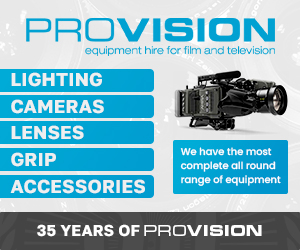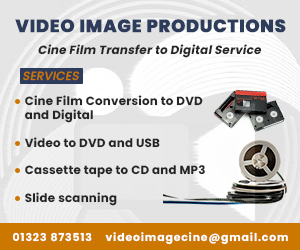Broadcast News
11/12/2015
Big Interview – Bluebell In A Nutshell

Based in the UK, Bluebell Opticom has been designing and manufacturing high-quality fibre optic transmission equipment for the broadcast, telecommunications and satellite industries since 1994. Specialising in 'point to point' fibre technology, today Bluebell has grown into an international organisation, as its Managing Director, Paul McCann, tells BFV...
BFV: Can you give us a brief history of Bluebell?
Paul: Bluebell started life on Blythe Road in Shepherds Bush, London, in 1994, just down the road from BBC Television Centre. In fact, the BBC was our first customer.
We started by developing a range of optical converters for the newly adopted serial digital interface. Sending SDI over standard coax cables didn't work over distances of more than 150 metres, thus opening a gap in the market for a fibre product.
We grew from two people in a basement in London with two products, to a truly international organisation with headquarters in Berkshire and partners in 28 countries. We have a broad spectrum of fibre converter products that have been tuned for ease of use and out-of-the-box operation. We spend a big percentage of revenue on research and design to stay in front of the technology curve. The result is that we can transport just about every signal prevalent in the broadcast arena over fibre cleanly, efficiently, and in a cost-effective package. We have come a long way in 21 years.
Bluebell has a range of products, manufactured to ISO9001 standards. As these standards have been developed and implemented, has this created additional challenges as technology continues to change?
The ISO 9001 standard is a quality assurance stamp and a guideline that controls how we build our equipment. In other words, it's a gauge for repeatability. We have a very rigid set of parameters for our process control. With ISO 9001 as a template, once we set the manufacturing process control, it is fixed through the life cycle of the product. Each piece of equipment of the same type is manufactured in exactly the same way, without deviation, even down to the heat profile of the surface mount reflow oven. Each component on the board has complete traceability back to the foundry where it was made. We even track which smelting plant was used for the gold on the circuit board and which country the tantalum comes from. This diligence allows us to comply with the international "conflict minerals" directive.
We also spend a lot of time on certifying our equipment. Because Bluebell is used all over the world, we keep abreast of safety and EMC compliance requirements globally. All of our equipment is rigorously tested for EMC emissions and immunity, CE certification, FCC compliance, CB safety compliance, EN 61000, EN 55022, Canada's ICES-003, EN 60950-1... The list goes on. This testing is an expensive necessity so that we can sell in every market worldwide – broadcast, satellite, telecommunication, military, sub-sea, medical, and education – and ensure all the boxes are ticked.
As technology advances, and components become smaller and more integrated, the process becomes more complex. For example, when we assemble a new board that uses some of our bigger FPGAs, we X-ray the prototypes to see that we have placed the FPGAs correctly. The process is then committed to our ISO 9001 documentation so that it stays right from then on.
We are very proud that all our equipment is made in the UK. We have resisted the temptation to manufacture our equipment offshore. Sure, it would be cheaper to build, and there would be a cost benefit per unit, but quality would suffer. We would lose the ability to control the very high standard that we have upheld since our beginning.
The company provides application-specific solutions for its customers and their events/projects. What does this entail?
Our application-specific products are a very important part of our overall offering, while our standard product range is the engine that drives Bluebell forward. Our standard products are well-known and used throughout the world, making up about 80 percent of our output. But the application-specific products, or "specials", are a bit more fun to create and require a different approach. We love it when a customer asks us for a device that will perform a specific function or set of functions. Not only do we get to fulfil the customer's requirement, but, if the product seems to have a broader appeal, we make a point of putting it into mass production in order to benefit more people.
One example was a specific requirement from an OB truck company in the U.S. who wanted to connect two talkback systems together using fibre. The difficulty was that the two systems used different control data formats, and sometimes the talkback systems had to be extended using a third system installed in the venue. The customer needed a multiformat data communications system with two discrete duplex audio channels. We were able to go from concept to shipping in a matter of months. The customer now has an open platform that will interoperate with most talkback systems on the market and is very happy with the result. We immediately saw that this unit, the BN623, could be deployed in many applications, so we put in into our product range, and it is selling well.
We also have tailored flypacks, racks, and caddies that can be formatted for any number of signal combinations. The secret is the modularity of our range. Our circuit board dimensions allow us to produce small, lightweight, and portable systems that are unique and durable.
There has been a lot of discussion regarding the transition to IP; has this affected Bluebell in any way?
To help our customers prepare for the future, we have already begun selling our 4K products, and our 8K fibre transport equipment is nearly ready, requiring only final testing. We have also been working on IP technologies for several years now.
To me, IP is one of the fastest-evolving sectors of broadcast technology. We all started with H.264 transport with IEEE 1588 for timing, then quickly moved to SMPTE 2022 in all its guises. Since IBC we have been learning about RFC 4175, a much more sensible and less bandwidth-hungry way of transporting program and control signals. Last month, the Video Services Forum published a draft document called "Transport of Uncompressed Elementary Stream Media over IP" (TR-03), describing how the new format operates. In essence, rather than wrapping up video, audio, and data in SDI using SMPTE embedding techniques and hiding the data in the vertical and horizontal blanking, the raw elements – video data, audio data, and data data – are decoded from the SDI transport stream and transported separately on individual ports on a network. We see potential in RFC 4175 and are exploring the benefits of incorporating such technology into our fibre transport products at some point.
Bluebell is one of the founding members of IPPG, an organisation set up to create a working ecosystem for IP-type broadcast products to ensure interoperability among equipment. IPPG also wants to ensure ease of operation wherein the technology is intelligent enough to work out what it is, what it should be connected to, and how. One of the biggest downsides of this IP age in broadcast is the setup time. Broadcasters traditionally like a plug-and-play kit. If IP devices require setting IP and MAC addresses, subnet masks, and the like, then people will shy away from using them.
I see a very exciting, diverse future in our industry, with all sorts of interesting engineering challenges. The medium and content will remain the same, but the format and protocols will evolve. And there will always be a need for fibre technology.
www.bluebellcomms.co.uk
This article is also available to read at BFV online.
BFV: Can you give us a brief history of Bluebell?
Paul: Bluebell started life on Blythe Road in Shepherds Bush, London, in 1994, just down the road from BBC Television Centre. In fact, the BBC was our first customer.
We started by developing a range of optical converters for the newly adopted serial digital interface. Sending SDI over standard coax cables didn't work over distances of more than 150 metres, thus opening a gap in the market for a fibre product.
We grew from two people in a basement in London with two products, to a truly international organisation with headquarters in Berkshire and partners in 28 countries. We have a broad spectrum of fibre converter products that have been tuned for ease of use and out-of-the-box operation. We spend a big percentage of revenue on research and design to stay in front of the technology curve. The result is that we can transport just about every signal prevalent in the broadcast arena over fibre cleanly, efficiently, and in a cost-effective package. We have come a long way in 21 years.
Bluebell has a range of products, manufactured to ISO9001 standards. As these standards have been developed and implemented, has this created additional challenges as technology continues to change?
The ISO 9001 standard is a quality assurance stamp and a guideline that controls how we build our equipment. In other words, it's a gauge for repeatability. We have a very rigid set of parameters for our process control. With ISO 9001 as a template, once we set the manufacturing process control, it is fixed through the life cycle of the product. Each piece of equipment of the same type is manufactured in exactly the same way, without deviation, even down to the heat profile of the surface mount reflow oven. Each component on the board has complete traceability back to the foundry where it was made. We even track which smelting plant was used for the gold on the circuit board and which country the tantalum comes from. This diligence allows us to comply with the international "conflict minerals" directive.
We also spend a lot of time on certifying our equipment. Because Bluebell is used all over the world, we keep abreast of safety and EMC compliance requirements globally. All of our equipment is rigorously tested for EMC emissions and immunity, CE certification, FCC compliance, CB safety compliance, EN 61000, EN 55022, Canada's ICES-003, EN 60950-1... The list goes on. This testing is an expensive necessity so that we can sell in every market worldwide – broadcast, satellite, telecommunication, military, sub-sea, medical, and education – and ensure all the boxes are ticked.
As technology advances, and components become smaller and more integrated, the process becomes more complex. For example, when we assemble a new board that uses some of our bigger FPGAs, we X-ray the prototypes to see that we have placed the FPGAs correctly. The process is then committed to our ISO 9001 documentation so that it stays right from then on.
We are very proud that all our equipment is made in the UK. We have resisted the temptation to manufacture our equipment offshore. Sure, it would be cheaper to build, and there would be a cost benefit per unit, but quality would suffer. We would lose the ability to control the very high standard that we have upheld since our beginning.
The company provides application-specific solutions for its customers and their events/projects. What does this entail?
Our application-specific products are a very important part of our overall offering, while our standard product range is the engine that drives Bluebell forward. Our standard products are well-known and used throughout the world, making up about 80 percent of our output. But the application-specific products, or "specials", are a bit more fun to create and require a different approach. We love it when a customer asks us for a device that will perform a specific function or set of functions. Not only do we get to fulfil the customer's requirement, but, if the product seems to have a broader appeal, we make a point of putting it into mass production in order to benefit more people.
One example was a specific requirement from an OB truck company in the U.S. who wanted to connect two talkback systems together using fibre. The difficulty was that the two systems used different control data formats, and sometimes the talkback systems had to be extended using a third system installed in the venue. The customer needed a multiformat data communications system with two discrete duplex audio channels. We were able to go from concept to shipping in a matter of months. The customer now has an open platform that will interoperate with most talkback systems on the market and is very happy with the result. We immediately saw that this unit, the BN623, could be deployed in many applications, so we put in into our product range, and it is selling well.
We also have tailored flypacks, racks, and caddies that can be formatted for any number of signal combinations. The secret is the modularity of our range. Our circuit board dimensions allow us to produce small, lightweight, and portable systems that are unique and durable.
There has been a lot of discussion regarding the transition to IP; has this affected Bluebell in any way?
To help our customers prepare for the future, we have already begun selling our 4K products, and our 8K fibre transport equipment is nearly ready, requiring only final testing. We have also been working on IP technologies for several years now.
To me, IP is one of the fastest-evolving sectors of broadcast technology. We all started with H.264 transport with IEEE 1588 for timing, then quickly moved to SMPTE 2022 in all its guises. Since IBC we have been learning about RFC 4175, a much more sensible and less bandwidth-hungry way of transporting program and control signals. Last month, the Video Services Forum published a draft document called "Transport of Uncompressed Elementary Stream Media over IP" (TR-03), describing how the new format operates. In essence, rather than wrapping up video, audio, and data in SDI using SMPTE embedding techniques and hiding the data in the vertical and horizontal blanking, the raw elements – video data, audio data, and data data – are decoded from the SDI transport stream and transported separately on individual ports on a network. We see potential in RFC 4175 and are exploring the benefits of incorporating such technology into our fibre transport products at some point.
Bluebell is one of the founding members of IPPG, an organisation set up to create a working ecosystem for IP-type broadcast products to ensure interoperability among equipment. IPPG also wants to ensure ease of operation wherein the technology is intelligent enough to work out what it is, what it should be connected to, and how. One of the biggest downsides of this IP age in broadcast is the setup time. Broadcasters traditionally like a plug-and-play kit. If IP devices require setting IP and MAC addresses, subnet masks, and the like, then people will shy away from using them.
I see a very exciting, diverse future in our industry, with all sorts of interesting engineering challenges. The medium and content will remain the same, but the format and protocols will evolve. And there will always be a need for fibre technology.
www.bluebellcomms.co.uk
This article is also available to read at BFV online.
Top Related Stories
Click here for the latest broadcast news stories.
19/06/2008
Trantec Releases New Product 2008 Product Catalogue
Trantec, the wireless mic systems designer and manufacturer, has launched its new 2008 product catalogue. This catalogue is their most comprehensive t
Trantec Releases New Product 2008 Product Catalogue
Trantec, the wireless mic systems designer and manufacturer, has launched its new 2008 product catalogue. This catalogue is their most comprehensive t
08/05/2018
Bluebell Opticom Receives Emmy® For SDI-Over-Fibre Technology
Bluebell Opticom Ltd has been awarded an Emmy® from the National Academy of Television Arts & Sciences (NATAS) for its SDI-over-fibre technology, at t
Bluebell Opticom Receives Emmy® For SDI-Over-Fibre Technology
Bluebell Opticom Ltd has been awarded an Emmy® from the National Academy of Television Arts & Sciences (NATAS) for its SDI-over-fibre technology, at t
16/02/2017
Enhance Your Product With BES' 4K Patching Equipment
Streaming services, live sporting events and even a small number of Blu-ray films are now available in 4K as Ultra High Definition content production
Enhance Your Product With BES' 4K Patching Equipment
Streaming services, live sporting events and even a small number of Blu-ray films are now available in 4K as Ultra High Definition content production
23/03/2018
Bluebell Opticom 2018 NAB Show Preview
At the 2018 NAB Show, Bluebell will demonstrate the Silhouette line of rugged, deployable, high-density, mixed-technology media converters. The heart
Bluebell Opticom 2018 NAB Show Preview
At the 2018 NAB Show, Bluebell will demonstrate the Silhouette line of rugged, deployable, high-density, mixed-technology media converters. The heart
22/03/2018
Bluebell Opticom At NAB 2018
Bluebell has announced that it will demonstrate the Silhouette line of rugged, deployable, high-density, mixed-technology media converters at the 2018
Bluebell Opticom At NAB 2018
Bluebell has announced that it will demonstrate the Silhouette line of rugged, deployable, high-density, mixed-technology media converters at the 2018
20/09/2021
Bluebell Opticom Confirms New Appointments
Bluebell Opticom Ltd is undertaking a series of new appointments that will enable even greater agility and responsiveness to both customer and market
Bluebell Opticom Confirms New Appointments
Bluebell Opticom Ltd is undertaking a series of new appointments that will enable even greater agility and responsiveness to both customer and market
23/10/2009
Bluebell Provides Fibre Optic Solution For SIS LIVE
Bluebell Opticom provides a complete fibre optic solution for the latest SISCaster compact OB vehicle for multi-platform event coverage. Bluebell has
Bluebell Provides Fibre Optic Solution For SIS LIVE
Bluebell Opticom provides a complete fibre optic solution for the latest SISCaster compact OB vehicle for multi-platform event coverage. Bluebell has
07/08/2009
Bluebell Provides Fibre Solutions To Gearhouse Broadcast
A large number of Shack fibre optic links has been supplied to international broadcast solutions company, Gearhouse Broadcast. The units, delivered by
Bluebell Provides Fibre Solutions To Gearhouse Broadcast
A large number of Shack fibre optic links has been supplied to international broadcast solutions company, Gearhouse Broadcast. The units, delivered by
07/08/2009
Bluebell Provides Fibre Solutions To SIVision
Bluebell has supplied a large number of Shack fibre optic links via their German distributor Teracue AG to leading German Outside Broadcaster, SIVisio
Bluebell Provides Fibre Solutions To SIVision
Bluebell has supplied a large number of Shack fibre optic links via their German distributor Teracue AG to leading German Outside Broadcaster, SIVisio
21/03/2016
Connecting Cameras And CCUs
An End-to-End Optical Infrastructure From Bluebell Opticom. By Paul McCann, Managing Director, Bluebell Opticom. For more than 20 years, Bluebell has
Connecting Cameras And CCUs
An End-to-End Optical Infrastructure From Bluebell Opticom. By Paul McCann, Managing Director, Bluebell Opticom. For more than 20 years, Bluebell has
04/05/2017
Bluebell Puts IP And 4K UHD Fibre Transport Front And Center At NAB
Spring is upon us in the northern part of the globe, and with it our thoughts turn to our annual trip to NAB. Our three main areas of focus this year
Bluebell Puts IP And 4K UHD Fibre Transport Front And Center At NAB
Spring is upon us in the northern part of the globe, and with it our thoughts turn to our annual trip to NAB. Our three main areas of focus this year
14/08/2007
Studio Network Solutions Extends Product Line with Ellipse Fibre Channel HBAs for Mac OS X
Studio Network Solutions (SNS), a premier provider of optimized audio/video shared storage products and developer of the globalSAN iSCSI initiator for
Studio Network Solutions Extends Product Line with Ellipse Fibre Channel HBAs for Mac OS X
Studio Network Solutions (SNS), a premier provider of optimized audio/video shared storage products and developer of the globalSAN iSCSI initiator for
05/01/2024
AGI Technology To Elevate The Storage Product Market
As 2023 concludes, AGI Technology, a Taiwanese storage brand, is set to elevate the storage product market with an unprecedented release. Shattering t
AGI Technology To Elevate The Storage Product Market
As 2023 concludes, AGI Technology, a Taiwanese storage brand, is set to elevate the storage product market with an unprecedented release. Shattering t
16/01/2023
Brompton Technology Appoints Cesar Caceres As New Product Lead
Brompton Technology has appointed Cesar Caceres, who will be joining the company's cross-functional product development team as their Product Lead. Ha
Brompton Technology Appoints Cesar Caceres As New Product Lead
Brompton Technology has appointed Cesar Caceres, who will be joining the company's cross-functional product development team as their Product Lead. Ha
20/12/2019
Ultrix IP Scoops TV Technology 2019 Product Innovation Award
Ross Video has announced that Ultrix IP – the IP blade that complements the innovative Ultrix Routing & AV Processing platform – has received a covete
Ultrix IP Scoops TV Technology 2019 Product Innovation Award
Ross Video has announced that Ultrix IP – the IP blade that complements the innovative Ultrix Routing & AV Processing platform – has received a covete















